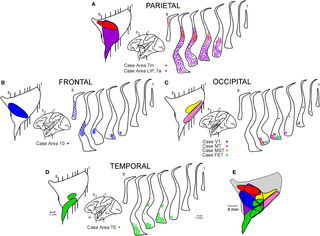Neuroscience
What the Heck Is a Claustrum?
A new announcement pushes this obscure brain region into the spotlight.
Posted February 27, 2017
Given its subjective nature, consciousness is already a controversial topic in the world of brain science. While some neuroscientists doubt that consciousness can even be studied, others still endeavor towards identifying parts of the brain that support subjective awareness. At a gathering of neuroscientists February 15 in Bethesda, Maryland, an announcement has thrust the quest to understand consciousness into the spotlight once again. A team of neuroscientists lead by Christof Koch has identified neurons in a relatively obscure brain region known as the claustrum that send fibers far throughout the entire cerebral cortex, well beyond where they are expected to project. One neuron shown in the presentation engulfed the brain like a "crown of thorns" with its colossal fibers. According to Nature News, “Koch sees this as evidence that the claustrum could be coordinating inputs and outputs across the brain to create consciousness.”
The hypothesis that one brain region might occupy a privileged position as the central gatekeeper of consciousness is sure to spark debate in a community that is often skeptical of almost any theory of consciousness in the first place. But before we explore the plausibility of this hypothesis, what the heck is a claustrum?
Unlike familiar friends such as the cerebral cortex, cerebellum, amygdala, or medulla, the claustrum feels like the mysterious neighbor in your apartment building whom you've never met. When we talk about the claustrum, we refer to an extremely thin sheet of neurons situated just below the insular lobe of the cortex, the hidden lobe which can only be seen by a surgeon if other parts of the cortex are pulled aside. Most, if not all, mammals have a claustrum. But, oddly enough, no one can definitely say what the claustrum does or why it's important. The scary truth is that no brain surgeon can really tell you what would happen if he or she removed this millimeters-thin blanket of neurons from your skull.

This is likely because the claustrum is too oddly shaped to easily manipulate or lesion. Each brain has two claustra oriented along a line pointing from the front of the head towards the back. Like a sloppy pancake hastily cooked on a camping trip, the human claustrum appears as a thin, convoluted sheet. Unlike the walnut shaped amygdala—a small, compact structure whose simple border might easily match the treacherous path of tissue death following a stroke—the strange anatomy of the claustrum means it cannot easily be lesioned without also damaging many neighboring brain structures. For this reason, doctors have yet to meet a patient whose claustral lesion or injury can be clearly associated with a behavioral or cognitive deficit. What's more, scientists cannot easily lesion the claustrum of an animal without damaging other areas of the brain. As a result, no experiment to date has clearly established a functional role for the brain's most curious piece of anatomy.
Another strange fact about the claustrum is its paucity of different cell types. Compared with the rich variety of neurons found in other parts of the brain such as the cortex, the claustrum features only a few different types of neurons. Given this fact, combined with the claustrum's vanishingly thin width, one might be tempted to dismiss the claustrum as a vestigial brain region, an anatomical structure like the human appendix which no longer serves any clear purpose, continuously whittled away generation after generation by the parsimonious hands of natural selection.
But there is much evidence that the above picture is wrong. The mouse claustrum broadcasts its importance by the shocking breadth of its projections that Koch's team has recently imaged. But could the human claustrum still be vestigial? This is also unlikely. A neuroimaging study of humans by Jack Van Horn and his colleagues at the University of Southern California revealed that no other brain structure of comparable volume has so many anatomical connections to other brain structures. In other words, the claustrum is like a tiny train station that, despite its compact size, sends and receives departures and arrivals from a vast number of other train stations. The extremely high connectivity of the claustrum suggests it is deceptively important in one or more brain networks. In fact, sensory input from almost all regions of the cortex arrives at the claustrum.

Given this revised image of the claustrum—a far cry from a neural appendix—a new fallacy beckons. It's not difficult to imagine the claustrum as a sort of command center of the brain, its interior lined with television monitors displaying the full activity of the brain while a little man sips lemonade and pushes buttons. We are perhaps further beckoned towards this questionable hypothesis by a published report of a woman with electrodes inserted deep into her brain to treat seizures. Stimulation delivered by an electrode between the left claustrum and the insular cortex caused the woman to lose consciousness, which she regained after the stimulation ended. Since other electrodes positioned nearby did not have the same effect, this case report is the closest thing scientists have to a proper lesion study of the claustrum.
So, is the claustrum a figurative command center? A similar concept was conceived by the seventeenth century French mathematician and philosopher Rene Descartes. Descartes imagined there was some point in the brain where all sensory information intersects and an eternal soul sits and watches. If fact, he imagined this place to be the pineal gland —a small endocrine gland in the brain—given its comfortable, centralized location between both cerebral hemispheres. For this reason, modern theories that emphasize one part of the brain as a command center or soul are often referred to as Cartesian Theaters. The metaphor of a little man sitting inside a theater in the brain and watching a display of all its contents is tempting, but its logic is circular. How does this little man watch the display? Where is his brain, and how does he make sense of the theater around him?

Koch and his late colleague Francis Crick, co-discoverer of the double helix structure of DNA, have commented on this view of the claustrum by emphasizing that the claustrum is more likely to be an orchestra conductor than a command center. Scientists such as Crick and Koch who study consciousness must explain why consciousness feels like one thing. For example, the shape, color, and size of a basketball are processed in different brain areas, despite the fact that all of these features are integrated into a whole. Many popular theories of consciousness, such as Giulio Tononi's Integrated Information Theory, emphasize the necessity of a brain that integrates information across many structures or modules in giving rise to consciousness. Tononi and others often point to the coexistence of both long-range and short-range anatomical connections within the cerebral cortex as supporting such integration. In this view, the responsibility of integrating information is distributed across the cortex by a web of different fibers. Consciousness is self-organized in the framework of this theory: not arising from any one place or module, but rather, the interactions amongst many different brain modules.
The idea that a structure such as the claustrum serves a privileged role as an orchestra conductor, synchronizing and integrating activity between cerebral hemispheres, appears to pose a subtle challenge to the prevailing image of the brain that emphasizes self-organization and distributed activity. Yet, even if this challenge holds merit, it's important to stress that the claustrum is likely to be merely necessary and not sufficient for consciousness. In other words, the distributed activity of other brain areas still matters greatly. The conductor might be needed for the orchestra to perform, but, needless to say, we still need the orchestra to play the music!
For now, theories about the claustrum's function remain speculative. While no study to date has rigorously demonstrated a function for this oddly shaped pancake, a possible approach would be to express special proteins called opsins in the claustrum that trigger neural activity when stimulated by light. In this way, neuroscientists could shine laser light on the claustrum to either excite or inhibit claustral neurons, thus teasing apart their causal relationship with different behaviors. This technique, called optogenetics, would require scientists to first identify a genetic fingerprint of genes expressed by claustral neurons before they could be targeted for opsin expression.
Even in light of Koch's recent announcement, the function of this unusual brain structure remains mysterious. In the ocean of the brain, there is plenty of uncharted territory yet to be explored. For young students studying the brain, many opportunities to make a name for oneself await. After all, where function is concerned, we still really don't know what the heck a claustrum is.
~
Watch Koch's talk at the BRAIN initiative meeting here (skip to 2:11:30).
~
References
Reardon, S. (2017). A giant neuron found wrapped around entire mouse brain. Nature News, Retrieved on February 26, 2017 from http://www.nature.com/news/a-giant-neuron-found-wrapped-around-entire-m…
Torgerson, C. M., Irimia, A., Goh, S. Y., & Van Horn, J. D. (2015). The DTI connectivity of the human claustrum. Human brain mapping, 36(3), 827-838.
Crick, F. C., & Koch, C. (2005). What is the function of the claustrum?. Philosophical Transactions of the Royal Society of London B: Biological Sciences, 360(1458), 1271-1279
Dennett, D. C. (1993). Consciousness explained. Penguin UK.




